Related Research Articles
The caper story is a subgenre of crime fiction. The typical caper story involves one or more crimes perpetrated by the main characters in full view of the reader. The actions of police or detectives attempting to prevent or solve the crimes may also be chronicled, but are not the main focus of the story.

The Killing is a 1956 American film noir directed by Stanley Kubrick and produced by James B. Harris. It was written by Kubrick and Jim Thompson and based on Lionel White's novel Clean Break. It stars Sterling Hayden, Coleen Gray, and Vince Edwards, and features Marie Windsor, Elisha Cook Jr., Jay C. Flippen and Timothy Carey.

Crime films, in the broadest sense, is a film genre inspired by and analogous to the crime fiction literary genre. Films of this genre generally involve various aspects of crime and its detection. Stylistically, the genre may overlap and combine with many other genres, such as drama or gangster film, but also include comedy, and, in turn, is divided into many sub-genres, such as mystery, suspense or noir.
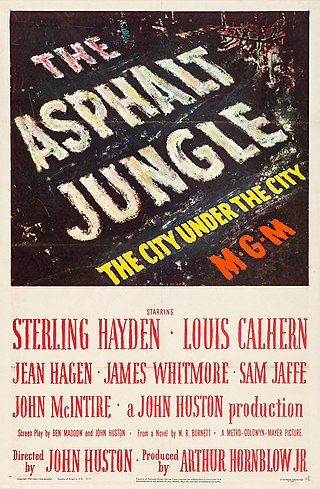
The Asphalt Jungle is a 1950 American heist film noir directed and co-written by John Huston, and starring Sterling Hayden and Louis Calhern, with Jean Hagen, James Whitmore, Sam Jaffe, John McIntire, and Marilyn Monroe in one of her earliest roles. Based on the 1949 novel of the same name by W. R. Burnett, it tells the story of a jewel robbery in a Midwestern city.

Heist is a 2001 American heist film written and directed by David Mamet and starring Gene Hackman, Danny DeVito and Delroy Lindo, with Rebecca Pidgeon, Ricky Jay and Sam Rockwell in supporting roles.

Rififi is a 1955 French crime film adaptation of Auguste Le Breton's novel of the same name. Directed by American blacklisted filmmaker Jules Dassin, the film stars Jean Servais as the aging gangster Tony "le Stéphanois", Carl Möhner as Jo "le Suédois", Robert Manuel as Mario Farrati, and Jules Dassin as César "le Milanais". The foursome band together to commit an almost impossible theft, the burglary of an exclusive jewelry shop in the Rue de la Paix. The centerpiece of the film is an intricate half-hour heist scene depicting the crime in detail, shot in near silence, without dialogue or music. The fictional burglary has been mimicked by criminals in actual crimes around the world.

Armored Car Robbery is a 1950 American film noir starring Charles McGraw, Adele Jergens, and William Talman.
A semidocumentary is a form of book, film, or television program presenting a fictional story that incorporates many factual details or actual events, or which is presented in a manner similar to a documentary.
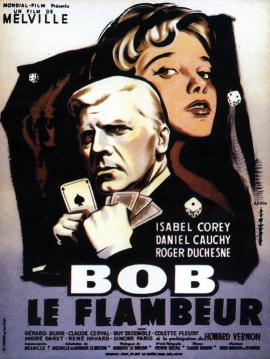
Bob le flambeur is a 1956 French heist gangster film directed by Jean-Pierre Melville and starring Roger Duchesne as Bob. It is often considered both a film noir and a precursor to the French New Wave, the latter because of its use of handheld camera and a single jump cut.

Le Cercle Rouge is a 1970 crime film set mostly in Paris. It was directed by Jean-Pierre Melville and stars Alain Delon, Bourvil, Gian Maria Volonté, François Périer and Yves Montand. It is known for its climactic heist sequence which is about half an hour in length and has almost no dialogue.
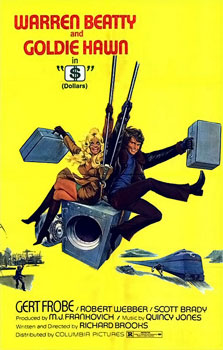
$, also known as Dollar$, Dollars or $ (Dollars), and in the UK as The Heist, is a 1971 American heist comedy film starring Warren Beatty and Goldie Hawn, written and directed by Richard Brooks and produced by M.J. Frankovich. The supporting cast includes Gert Fröbe, Robert Webber and Scott Brady. The film is about a bank security consultant (Beatty) who develops a scheme with a prostitute, Dawn Divine (Hawn), to steal several criminals' money from a bank vault.
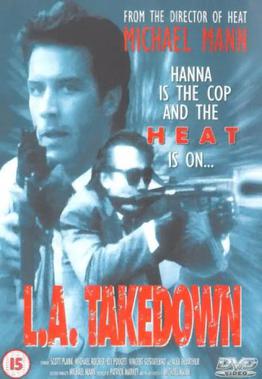
L.A. Takedown, also called L.A. Crimewave and Made in L.A., is a 1989 American crime action film written and directed by Michael Mann. Originally filmed as a pilot for an NBC television series, the project was reworked and aired as a stand-alone TV film after the series was not picked up. The film was later released on VHS and, in Region 2, on DVD.
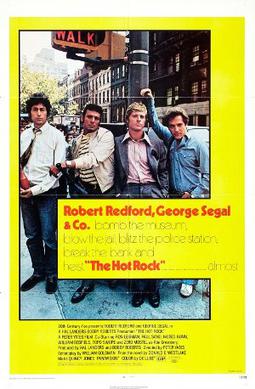
The Hot Rock is a 1972 American crime comedy-drama film directed by Peter Yates from a screenplay by William Goldman, based on Donald E. Westlake's novel of the same name, which introduced his long-running John Dortmunder character. The film stars Robert Redford, George Segal, Ron Leibman, Paul Sand, Moses Gunn and Zero Mostel. It was released in the UK with the alternative title How to Steal a Diamond in Four Uneasy Lessons.

The Split is a 1968 American neo-noir crime drama film directed by Gordon Flemyng and written by Robert Sabaroff based upon the Parker novel The Seventh by Richard Stark.

Family Business is a 1989 American neo noir crime film directed by Sidney Lumet, with a screenplay by Vincent Patrick, based on his novel. It stars Sean Connery, Dustin Hoffman and Matthew Broderick.

The Big Caper is a 1957 American film noir crime film directed by Robert Stevens and starring Rory Calhoun, Mary Costa and James Gregory.

Thriller film, also known as suspense film or suspense thriller, is a broad film genre that evokes excitement and suspense in the audience. The suspense element found in most films' plots is particularly exploited by the filmmaker in this genre. Tension is created by delaying what the audience sees as inevitable, and is built through situations that are menacing or where escape seems impossible.
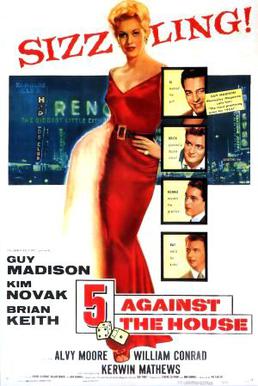
5 Against the House is a 1955 American heist film directed by Phil Karlson and starring Guy Madison, Kim Novak and Brian Keith. The supporting cast includes William Conrad. The screenplay is based on Jack Finney's 1954 novel of the same name, later serialized by Good Housekeeping magazine. The film centers on a fictional robbery of what was a real Nevada casino, Harold's Club.

A gangster film or gangster movie is a film belonging to a genre that focuses on gangs and organized crime. It is a subgenre of crime film, that may involve large criminal organizations, or small gangs formed to perform a certain illegal act. The genre is differentiated from Westerns and the gangs of that genre.

Locked Down is a 2021 American romantic comedy heist film directed by Doug Liman and written by Steven Knight. The film stars Anne Hathaway and Chiwetel Ejiofor, with Stephen Merchant, Mindy Kaling, Lucy Boynton, Mark Gatiss, Claes Bang, Ben Stiller, and Ben Kingsley in supporting roles.
References
- 1 2 3 4 5 6 "One last big job: How heist movies tell their stories". Observations on film art. Retrieved October 21, 2021.
- 1 2 3 4 5 Kaminsky, Stuart (1974). American film genres: approaches to a critical theory of popular film. Dayton Ohio: Pflaum Pub. pp. 74–97. ISBN 0827802781.
- ↑ Perno, G. S. (August 9, 2015). "10 Ways That Heists in Movies Usually Go Wrong". Cinelinx | Movies. Games. Geek Culture. Archived from the original on October 21, 2021. Retrieved October 21, 2021.
- 1 2 Hardy, Phil (1997). he BFI Companion to Crime. A & C Black. pp. 70–71. ISBN 9780304332151.
- 1 2 3 4 5 6 7 8 9 10 11 12 Lee, Daryl (December 31, 2014). The Heist Film. doi:10.7312/lee-16969. ISBN 9780231169691.
- ↑ Billson, Anne (October 30, 2018). "Why is Seven Samurai so good?". BBC Culture. BBC . Retrieved May 31, 2020.
- 1 2 3 Hunter, Rob (September 6, 2018). "The Best Diamond Heist Movies You've Never Seen". /Film . Retrieved February 20, 2019.
- 1 2 Haltof, Marek (2015). Historical Dictionary of Polish Cinema. Rowman & Littlefield. pp. 127, 148, 253. ISBN 978-1-4422-4472-6.
- ↑ Wilson, Ron (2000). "The Left-Handed Form of Human Endeavour" . In Dixon, Wheeler W. (ed.). Film Genre 2000: New Critical Essays. SUNY Press. pp. 154–155. ISBN 978-0-7914-4513-6.
- ↑ Truitt, Brian (May 20, 2021). "'Like Braveheart but flipped': Zack Snyder evolves zombies in a big way for 'Army of the Dead'". USA Today . Retrieved May 25, 2021.
- 1 2 3 4 5 6 7 8 9 10 Morris, Brogan (September 14, 2018). "10 great heist films". bfi.org.uk. British Film Institute . Retrieved October 30, 2018.
- 1 2 3 4 5 6 7 8 9 10 11 12 13 14 15 16 17 18 19 20 Dockterman, Eliana (August 18, 2017). "The 25 Best Heist Movies". Time . Retrieved October 30, 2018.
- ↑ Moore, Roger (April 23, 2022). "Movie Review: An "Ocean's" caper for kiddies — "The Bad Guys"". Movie Nation. Retrieved May 29, 2022.
- 1 2 3 Axmaker, Sean (April 9, 2020). "Art of the steal: Here are some great heist/caper films to stream". Seattle Times . Retrieved June 6, 2020.
- 1 2 3 4 5 6 7 8 9 Staff, Playlist (September 10, 2010). "25 All-Time Favorite Heist Movies". IndieWire . Retrieved February 20, 2019.
- ↑ Burlingame, Russ (July 17, 2015). "Ant-Man's Most Overlooked Cameo: Ant-Man Himself". Comicbook.com. Archived from the original on July 20, 2015. Retrieved July 18, 2015.
- ↑ Gleiberman, Owen (January 18, 2018). "Film Review: 'Den of Thieves'" . Retrieved September 1, 2020.
- ↑ Maslin, Janet (April 30, 1999). "Film Review; They're a Devilish Match, But Who's Conning Whom?". The New York Times . Retrieved December 16, 2020.
- ↑ Atanasov, Dr. Svet (January 25, 2022). "Gambit Blu-ray".
- 1 2 Dalton, Stephen (November 7, 2012). "Gambit: Film Review". The Hollywood Reporter.
- 1 2 Robey, Tim (March 23, 2017). "The timeless appeal of the heist movie" . The Telegraph . Archived from the original on January 12, 2022. Retrieved April 15, 2020.
- ↑ "Here's one we saw earlier". the Guardian. November 25, 2001. Retrieved October 12, 2020.
- ↑ Klimek, Chris (August 11, 2016). "'Hell Or High Water' Is A Smart, Substantive Heist Film". npr.org. NPR . Retrieved May 29, 2020.
- ↑ "Hell's Angels '69 (1969) - Lee Madden | Synopsis, Characteristics, Moods, Themes and Related | AllMovie".
- ↑ Attenborough, Richard (1997). "The Caper Film". The BFI Companion to Crime. University of California Press. p. 71. ISBN 978-0-520-21538-2.
- ↑ Rajadhyaksha, Ashish; Willemen, Paul (1998) [1994]. Encyclopaedia of Indian Cinema (PDF). British Film Institute and Oxford University Press. p. 503. ISBN 0-19-563579-5. Archived (PDF) from the original on August 21, 2016. Retrieved September 24, 2021.
- 1 2 3 4 5 Leitch, Will; Gierson, Tim (June 7, 2018). "The 25 Best Heist Movies of All Time". Vulture . Retrieved May 29, 2020.
- ↑ Tobias, Scott (January 24, 2019). "'King Of Thieves': Bank Heist Film Deposits A Great Cast But Withdraws The Style". npr.org. NPR . Retrieved May 29, 2020.
- ↑ Wolff, Rachel (May 1, 2009). "Planning a Romantic Getaway".
- ↑ "Mankatha – Strictly No Rules". BBFC. Retrieved November 22, 2020.
- ↑ "Ajith & Venkat Prabhu joins for Mangatha!". Sify . 2010. Archived from the original on July 19, 2010. Retrieved July 16, 2010.
- ↑ Tallerico, Brian. "The Misfits movie review & film summary (2021) | Roger Ebert". RogerEbert.com . Retrieved August 21, 2021.
- ↑ Travers, Peter (June 8, 2007). "Ocean's Thirteen". Rolling Stone . Retrieved June 13, 2020.
- ↑ Powers, James (March 20, 2019). "'The Pink Panther': THR's 1964 Review". The Hollywood Reporter.
- ↑ Variety Staff (January 1, 1975). "The Return of the Pink Panther". Variety.
- ↑ Nathan, Ian (July 31, 2006). "Return Of The Pink Panther". Empire.
- ↑ Ebert, Roger (July 13, 2001). "The Score movie review & film summary" . Retrieved November 10, 2020.
- ↑ Kehr, Dave (September 9, 1992). "SLEEK 'SNEAKERS' FITS HEIST GENRE LIKE AN OLD SHOE". Chicago Tribune . Retrieved October 27, 2020.
- ↑ Borah, Meeta (January 22, 2024). "6 action-packed dystopian movies like Badland Hunters". Sportskeeda . Archived from the original on January 22, 2024. Retrieved February 17, 2024.
- ↑ Ebert, Roger (October 17, 1968). "The Split, Roger Ebert review". rogerebert.com . Retrieved April 3, 2020.
- ↑ Patten, Dominic (October 25, 2019). "'Mindhunter's Holt McCallany Riding Shotgun With Jason Statham In Guy Ritchie's New Heist Movie". Deadline Hollywood. Retrieved June 18, 2021.